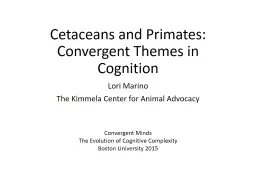

Lori Marino The Kimmela Center for Animal Advocacy Convergent Minds The Evolution of Cognitive Complexity Boston University 2015 Outline What is convergence Background on primate and cetacean evolution ID: 911186
Download Presentation The PPT/PDF document "Cetaceans and Primates: Convergent Theme..." is the property of its rightful owner. Permission is granted to download and print the materials on this web site for personal, non-commercial use only, and to display it on your personal computer provided you do not modify the materials and that you retain all copyright notices contained in the materials. By downloading content from our website, you accept the terms of this agreement.
Slide1
Cetaceans and Primates: Convergent Themes in Cognition
Lori MarinoThe Kimmela Center for Animal Advocacy
Convergent Minds
The Evolution of Cognitive Complexity
Boston
University 2015
Slide2Outline
What is convergence?Background on primate and cetacean evolutionConvergent evolution of large brainsConvergent cognition
Conclusions
Slide3What is convergent evolution?
Convergent evolution
is the acquisition of the same or similar biological traits in distantly-related lineages.
A
B
C
C
Analogous traits
Functional convergence
is the acquisition of the same or similar biological
functions
in distantly-related lineages.
Example: flight
Slide4Cognitive Convergence
Phylogenetically
distantly related (95
mya
)
Evolved in very different physical environments
Represent different neuroanatomical paths to complexity
Convergence in
those processes that comprise the way an organism thinks (functional definition).
Primates
Cetaceans
Slide5Convergence is relative – not all-or-nothing(because all life on earth is related by common descent and evolution is conservative)
How much do bottom levels constrain top levels?(Phylogenetic inertia, historical burden, etc.)
Homologies in
b
asic mechanisms
of informationprocessing
Slide6Convergence depends upon the level of analysis(because “examples of convergence” only “exist”within defined contexts)
Functional? Flight - yes
Behavioral? Depends
Anatomical? Depends
Structural? Depends
Chemical? No Molecular? No
Slide7Convergence is a complex concept and this isIllustrated in comparisons of primate and cetacean
c
ognition.
Slide8Background
Slide9Courtesy of
Jon Kaas
Most recent
ancestral group
that eventually
led to primates
and cetaceans
lived approx.
95
million years ago.
Slide10Very simple chronology of primate and cetacean evolution
Mysticetes
Modern
odontocetes
Modern
Humans
(200K ya)Odontocetes
Slide11Evolution of Large BrainsIn Primates and Cetaceans
The
common ancestor of primates and cetaceans
did not possess a large brain and, by inference, was
not especially cognitively
sophisticated. Therefore, any cognitive features shared by modern cetaceans and primates that we can reasonably expect were absent in the common ancestor are contenders as examples of cognitive convergence
1800 g1300 g
Slide12Encephalization Quotient (EQ)
The extent to which a species’ average adult brain size exceeds (or falls below) the size that would be expected compared with other species of the same body size.
EQ = 1 “average”
EQ <1 “below average”
EQ >1 “above average”
Slide13Marino (1995
, 1998, 2002,
2004)
EQ
5.0
3.0
7.0
Modern
delphinids
have the second highest EQs on the planet next to modern humans (and greater than our ape relatives)
*
*
*
*
* = p < .05
rough-toothed dolphin
Orca
1.0
Average
Convergent for Large Brains and High EQ Levels
Slide14Marino,
McShea
, and Uhen (2004
)
Odontocete
EQ increased significantly ~ 35
mya
Slide15Montgomery, Geisler, McGowen, ox, Marino, Gatesy (2013)
Cetaceans reached higher levels of EQ before primates (Panel C).
In contrast to cetaceans, primate evolution is characterized by a directional upward
t
rend in brain mass, not body mass, resulting in a strong trend toward increasing relative brain size. No such trend is found in cetaceans.
Contrasts in Encephalization Patterns
Slide16When brains enlarge they do not simply become larger versions of the smaller form. When brains enlarge they
reorganize and add new features in order to maintain connectivity and processing rate.Primate and cetacean brains took two different paths (divergence) to becoming large (convergence).
Slide17Gorilla
Human
Bottlenose
Dolphin
1 mm
I
II
III
I
II
III
V
VI
VI
VIVHaug, 1987
Slide18The adult orca brain is the most convoluted brain on earth.
Marino et al (2004)
Neocortical
expansion
The dolphin and whale neocortex is thinner than modern human neocortex
but has more surface area.
Surface area~2275cm
2
Surface area~3745cm
2
Slide19TOPOGRAPHY OF PRIMARY AND SECONDARY PROJECTION REGIONS
from Morgane et al. 1986
Rabbit
Cat
Rhesus monkey
Bottlenose dolphin
Slide20Cetacean mode of
neocortical expansion
Primate mode of
neocortical expansion
TWO WAYS TO BUILD LARGE BRAINS?
Emphasis on
multiplication of units
Modification andmultiplication ofcolumns
Glezer
et al Hypothesis: The cetacean brain may represent the most highly developed version of a particular kind of expansion that involved substantial multiplication of vertical columns.
Slide21Cetacean and primate brains are convergent for high EQ but divergent in the way that was accomplished. Given the two different kinds of neocortical organization represented by primates and cetaceans – is there evidence for cognitive convergence?
Slide22Convergent Cognition
Slide23Dolphins (and many other cetaceans) possess cognitive characteristics that are rare in the animal kingdom in general and typically shared with primates and a few other highly intelligent species.
Slide24Comprehension of Symbolic Communication
Slide25Self-recognition: the ability to recognize oneself in a mirror
Slide26Cultural Traditions
Slide27At what level are these traits convergent?
Behavioral
Functional
Structural
Slide28Conclusion
The comparative
evolutionary history of cetacean
and primate brains and cognition
is a powerful example of the way that brain structure-function relationships can follow a
dynamic and complex pattern of divergence and convergence at different levels over time.
Slide29Thank you to:Russell PowellIrina MikhalevichBoston University Center for Humanities
The John Templeton FoundationWashington University-St. Louis